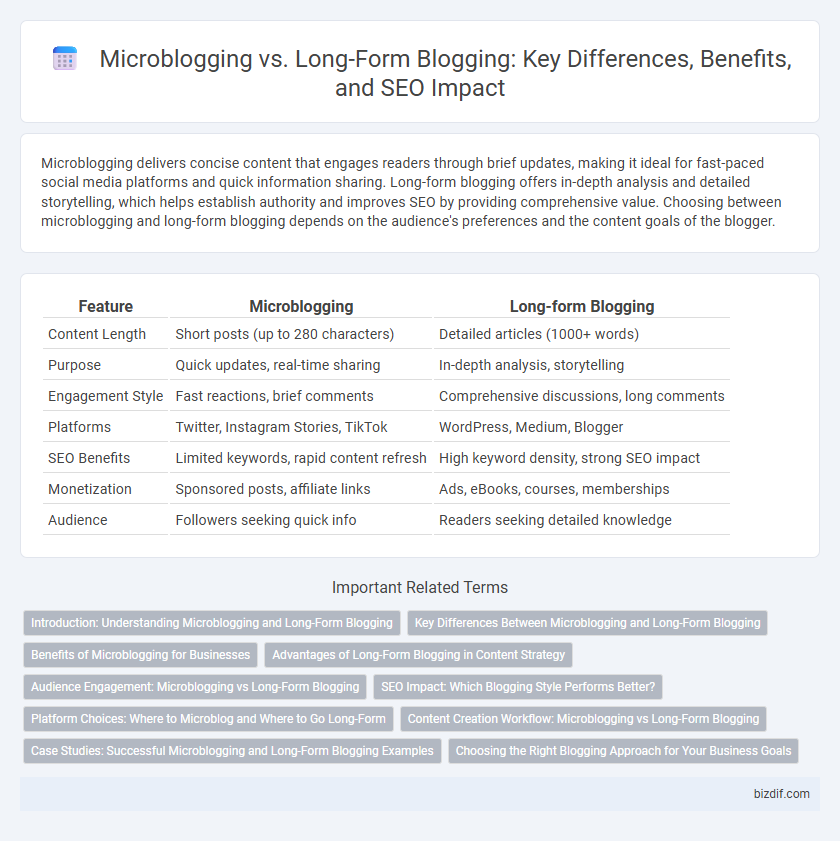Microblogging delivers concise content that engages readers through brief updates, making it ideal for fast-paced social media platforms and quick information sharing. Long-form blogging offers in-depth analysis and detailed storytelling, which helps establish authority and improves SEO by providing comprehensive value. Choosing between microblogging and long-form blogging depends on the audience's preferences and the content goals of the blogger.
Table of Comparison
| Feature | Microblogging | Long-form Blogging |
|---|---|---|
| Content Length | Short posts (up to 280 characters) | Detailed articles (1000+ words) |
| Purpose | Quick updates, real-time sharing | In-depth analysis, storytelling |
| Engagement Style | Fast reactions, brief comments | Comprehensive discussions, long comments |
| Platforms | Twitter, Instagram Stories, TikTok | WordPress, Medium, Blogger |
| SEO Benefits | Limited keywords, rapid content refresh | High keyword density, strong SEO impact |
| Monetization | Sponsored posts, affiliate links | Ads, eBooks, courses, memberships |
| Audience | Followers seeking quick info | Readers seeking detailed knowledge |
Introduction: Understanding Microblogging and Long-Form Blogging
Microblogging involves sharing brief updates, typically under 280 characters, optimizing quick engagement on platforms like Twitter and Instagram. Long-form blogging entails comprehensive posts exceeding 1,000 words, providing in-depth information and SEO benefits on personal or business websites. Both formats serve distinct purposes in digital marketing strategies, catering to varied audience preferences and content consumption habits.
Key Differences Between Microblogging and Long-Form Blogging
Microblogging involves brief, concise posts typically under 280 characters, ideal for real-time updates and quick interactions on platforms like Twitter and Instagram. Long-form blogging provides in-depth content, often exceeding 1,000 words, enabling detailed storytelling, thorough analysis, and comprehensive information on websites or blogs. The key differences lie in content length, depth of information, audience engagement style, and platform suitability for specific goals in digital marketing and personal branding.
Benefits of Microblogging for Businesses
Microblogging offers businesses rapid content delivery and increased engagement through concise, frequent updates on platforms like Twitter and Instagram. It enhances brand visibility and customer interaction by utilizing hashtags and real-time communication. This approach supports agile marketing strategies, fostering immediate feedback and viral sharing opportunities.
Advantages of Long-Form Blogging in Content Strategy
Long-form blogging offers in-depth exploration of topics, enhancing SEO through comprehensive keyword integration and higher user engagement metrics like increased time on page. Detailed content establishes authority and trust, improving search engine rankings and attracting a loyal audience. Its extensive format supports thorough storytelling and complex ideas, fostering deeper connections with readers and encouraging social sharing.
Audience Engagement: Microblogging vs Long-Form Blogging
Microblogging drives audience engagement through quick, frequent updates that encourage immediate interaction, making it ideal for real-time conversations and trending topics. Long-form blogging fosters deeper engagement by providing comprehensive insights, allowing readers to connect emotionally and intellectually with the content. Both formats excel in audience engagement by catering to different attention spans and content consumption preferences.
SEO Impact: Which Blogging Style Performs Better?
Microblogging generates frequent, easily digestible content that can boost keyword diversity and increase indexing speed, enhancing SEO performance through consistent updates. Long-form blogging, with its in-depth analysis and comprehensive keyword targeting, typically drives higher engagement metrics, longer dwell time, and improved search rankings for competitive terms. Combining microblogging for topical relevance and long-form posts for authority creates a balanced SEO strategy that maximizes visibility.
Platform Choices: Where to Microblog and Where to Go Long-Form
Microblogging platforms like Twitter and Tumblr excel at real-time updates and concise content, perfect for quick engagement and trending topics. Long-form blogging thrives on platforms such as WordPress and Medium, offering robust customization and in-depth readership analytics that support detailed storytelling and SEO optimization. Choosing the right platform depends on content goals, whether prioritizing brevity and immediacy or depth and permanence.
Content Creation Workflow: Microblogging vs Long-Form Blogging
Microblogging offers a rapid content creation workflow with concise posts that prioritize quick engagement and frequent updates, leveraging platforms like Twitter and Instagram for real-time interaction. Long-form blogging demands a more structured and time-intensive process, involving in-depth research, detailed outlines, and comprehensive drafts optimized for SEO and audience retention on platforms such as WordPress or Medium. Both workflows require strategic planning, but microblogging emphasizes agility and brevity, while long-form blogging centers on depth and sustained value.
Case Studies: Successful Microblogging and Long-Form Blogging Examples
Case studies reveal that Twitter's microblogging success leverages concise, engaging content to boost real-time user interaction, while platforms like Medium illustrate how long-form blogging enhances in-depth storytelling and SEO ranking. Brands using microblogs see rapid audience growth by sharing frequent updates, whereas long-form bloggers attract niche readers through comprehensive, evergreen articles. Examining HubSpot's dual-content strategy highlights how integrating micro and long-form posts optimizes reach and establishes authority within digital marketing.
Choosing the Right Blogging Approach for Your Business Goals
Microblogging delivers concise, timely content that drives quick engagement and is ideal for brands targeting rapid interaction and frequent updates on social media platforms like Twitter and Instagram. Long-form blogging allows for in-depth exploration of topics, boosting SEO performance and establishing authority, making it suitable for businesses aiming to educate audiences and build long-term relationships. Selecting the right approach depends on aligning content strategy with specific business goals such as brand awareness, lead generation, or customer retention.
Microblogging vs Long-form blogging Infographic

 bizdif.com
bizdif.com